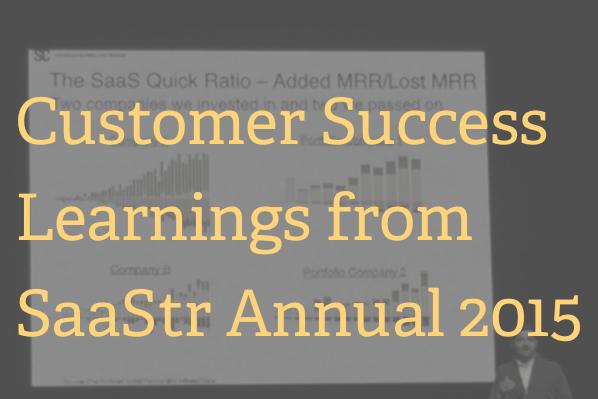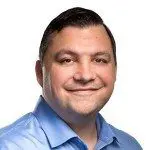Last Thursday was the first (of many, I hope) SaaStr Annual conference in San Francisco and it was awesome!
From the venue, to the “between two ferns” interview setup, to the fact that CEOs from some of the hottest companies – including current Gainsight customers Box, OpenDNS, MobileIron, and Influitive – were there to share their stories, this was one of the best events I’ve been to in recent memory. It will only be topped by Pulse 2015 in May.
This was not a Customer Success event – it was focused on SaaS in general. Yet the one thing that stuck out to me more than all of those aspects of the event is that Customer Success – either as an operational function as in Customer Success Management or as in lower-case “customer success” of just helping customers achieve their desired outcome – was a theme that ran through every interview, discussion, and presentation.
In fact, it was really interesting to hear how Customer Success thinking permeates every stage of the company lifecycle, which is how I’ll break down what was covered at the event.
It all starts with…
Early Days and Customer Development
Customer Success actually started very early for several of the founding CEOs who mentioned that they met with a lot of potential customers (Tiago Paiva, CEO of TalkDesk met with 50, Kris Duggan, CEO of BetterWorks met with 85) before they even built their product – a process called Customer Development – ensuring that they really understood the Desired Outcome of their customers and built a product that helped in that pursuit.
Aaron Levie said that in the early days as CEO of Box he was very product-focused. But as the customers became less and less like Box (i.e. they weren’t startups with very simple use cases) he was forced to become more customer-centric.
There came a point where they realized they simply couldn’t continue to develop Box in a vacuum and continue to make something that actually helped customers achieve their Desired Results; he had to get out of the building.
In fact, Levie said – thanks to the power of hindsight – he would have started the process of talking to customers earlier.
But Levie cautioned that being “customer-centric” is not the same as doing whatever the customer wants. In fact one of the criticisms of Customer Development is that if you ask a customer or prospect what they want, they’ll tell you a feature or some functionality that they’d like.
This is the “they’d just tell me they want a faster horse” quip generally attributed to Henry Ford… or how Steve Jobs never asked customers what they wanted.
But real Customer Development – and real Customer Success Management – isn’t about features and functions, it’s about understanding the Desired Outcome of your customers, and then solving for that. You should know that your customers want to go faster and carry more cargo; Ford solved for that. Jobs knew that customers wanted to be entertained and consume information; so he solved for that with the iPod, iPhone, and iPad.
Ford and Jobs knew their customers better than the customers knew themselves… when you do that, too, you won’t fall into the trap of giving your customers whatever they ask for; you’ll know what is needed to get them to their Desired Outcome and deliver that.
Which brings up…
Customizations and Distractions
Going back to the “is the customer always right?” question, Nicolas Dessaigne, CEO of Algolia, said they have turned down lucrative one-off deals as they would have been more of a distraction than something that truly helped move the company forward.
Levie said at Box they’ve been known to lose deals when their product doesn’t hit on every item on the checklist of the prospect and that’s okay; they’re not in the business of making one-off changes just to land a single customer.
However, with some prodding from Jason Lemkin, Levie said they might move something that’s already in the development pipeline (that will help everyone) up if that will help land a big account, but that’s really the extent of customizations.
This usually isn’t a problem for Box, though, as they’re typically able to show the customer how they’ll help them achieve their Desired Outcome even if every item on their checklist isn’t checked.
One of the biggest takeaways is that…
Customer Success Starts Early in the Customer Lifecycle
Now, once you have a product that will help your customers achieve their Desired Outcome, you need to actually sell it to those prospects, right? Well, Bob Tinker, CEO of MobileIron had some sage advice for the audience: “arguing with your customers about how they buy your software is a bad way to start a sales process.”
Sometimes you have an idea of how you want to sell your product, and maybe you’ve decided to sell in a self-service way via Credit Card. That’s great… if your customers want to/can buy products that way!
Part of the Customer Development process is figuring out how they buy (otherwise you’re not really doing “customer” development) and then creating a buying process that fits their requirements.
If Customer Success is about ensuring your customers achieve success with your product and you create artificial barriers (like an incongruent buying process) that stand in the way of them getting started with – and therefore getting value from – your product… you’re doing it wrong.
In fact, Customer Success must be part of the pre-customer phase: in the sales process, in the customers’ buying process, and should even be in your marketing.
Or it should just BE your marketing.
As Stewart Butterfield, CEO of Slack, said in a unique and wonderful way: “Everything we do is marketing. From UI copy to Customer Success. What people think of us is a sum of all of that.”
Now, once you have customers, every CEO will face this dilemma…
CEO Time Allocation: Customers vs. Prospects
Okay, so once you’ve gone through a proper Customer Development process and started selling your product to customers, as CEO you have a decision to make; spend time with prospects or existing customers?
Jason Lemkin, former CEO of EchoSign (Acquired by Adobe), VC at Storm Ventures, and the host of the SaaStr conference, said CEOs should spend more time with existing customers. From learning about how they’re using the product to ensuring they stick around and spend more (and all of the great things that come along with that), it’s imperative that a CEO make existing customers a priority.
We learned that several of the CEOs of the high-growth companies represented, when asked if they spend more time with prospects or existing customers, said they spend at least 50% of the time with customers, – and not just on web conferences or the phone, but in-person – and the other 50% with prospects.
But David Ulevitch, CEO of OpenDNS, said he spends fully 50% of his time overall with customers and prospects, as he understands the value in ensuring customers stay, grow, and advocate for them.
MobileIron CEO Bob Tinker says to spend a lot of time with customers in the early days – including selling – before you invest in ramping your sales organization.
And while steak dinners work well to close prospects – yes, this is 2015 – many CEOs recommended having a good number of existing customers – Ulevitch said 1:5 ratio of customers to prospects – on hand and even having the customers share case studies of their success with the product with the group.
The final – and awesome – note on this topic is from the Keith Kitani, CEO of Guidespark who actually carries a customer meeting quota assigned to him by his SVP of Sales.
If it’s important, operationalize it!
Speaking of that…
Operationalized Customer Success Management
Customer Success Management – literally the management of the process of ensuring your customers achieve their Desired Outcome with your product – is clearly something Box, OpenDNS, MobileIron, and Influitive have all operationalized as customers of Gainsight.
But at SaaStr it went deeper than that, as we heard from the second-time CEO panel – Mark Organ from Influitive, Kris Duggan of BetterWorks, and Nick Mehta of Gainsight – who all said they learned just how critical Customer Success was to the success of their first company, that this time around their first hires were in Customer Success Management.
Bob Tinker, CEO of MobileIron said it best: “making your customers successful has one of the highest ROIs of anything you’ll do.” Music to my ears.
Of course, operationalized Customer Success Management leads to…
Upsells and Expansion Revenue
Daniel Chait, CEO of Greenhouse, said you need to know your customers and develop a pricing strategy that fits them, and that includes having a pricing model that grows with your customers.
In fact, Aaron Levie said that you really should have a business model where you can grow the breadth and depth of customers’ usage – and therefore grow your revenue from existing customers.
And on this topic, Bob Tinker from MobileIron said: “nurture your customers. The initial sale is just a small event on the land-and-expand journey.”
Mark Organ, founder of Elouqa and Influitive says expansion revenue through cross-sell and upsell – driven by Customer Success – is such a focus for them that it now drives their product development roadmap. They are constantly coming out with new add-ons specifically to drive expansion revenue from existing customers.
BTW, if you’re interested in learning how to operationalize your Upsell process, check out our latest guide titled: “13 Tips to More Effective Upsells”
Jason Lemkin reminded us that in Enterprise deals, that procurement rules of the customer often build in an extra 25% of the contract value for Professional Services, so why not offer that as an upsell instead of missing out on that revenue? I’ll add that – if done correctly – whatever is included in that Professional Services engagement will help to make the customer stick around longer, use more, and become an advocate for you.
So it should be obvious if you’ve focused on Customer Success in everything you’ve done to this point, this last section coming up won’t be much of an issue… but if you haven’t, this should hit home why focusing on Customer Success is critical to your success in the SaaS business.
Churn Mitigation and the Compounding Nature of Retention
In what was the only actual Powerpoint presentation of the day, Mamoon Hamid, General Partner at The Social + Capital Partnership, a Venture Capital firm in Palo Alto that has invested in many of the current crop of $1B+ “unicorns,” dropped some knowledge on the crowd that left most people speechless.
Hamid’s presentation is one of the best presentations on churn that I’ve ever seen. His presentation does a great job of accurately showing just how churn impacts growth AND how expansion MRR can be used to hide cancelled or contraction (lower usage, down-sells, discounts, etc.) churn… and also shows why he passed on some investments that “looked good” at first.
Among other things, the “SaaS Quick Ratio” of Added MRR divided by Lost MRR as a quick way to judge whether a company is growing the right way or not was super-interesting. I won’t spoil the rest of it for you, I’ll embed the presentation below so you can see for yourself.
But make no mistake: a focus on Customer Success has an absolutely quantifiable impact not just on your bottom line, but on your company valuation, your ability to get funding and… whether or not you’ll turn into a Unicorn.

